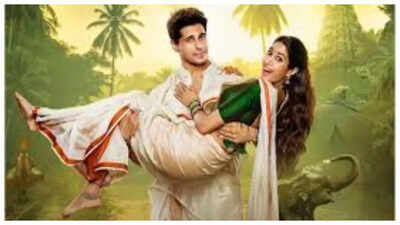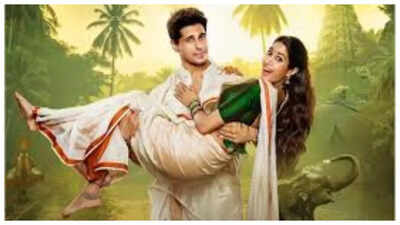Metro In Dino, Saiyaara, Param Sundari, and more test the fate of romance at the box office this July. Will Bollywood love stories survive?
Romantic Films Face Box Office Test: July Releases Stir Buzz but Mixed Response from Audiences
This July has become a critical test for the romantic film genre in Bollywood. After months of action thrillers and masala entertainers dominating the big screen, romantic dramas have made a strong comeback with four notable releases: Metro… In Dino, Aap Jaisa Koi, Saiyaara, and Param Sundari. Each film has attempted to revive the genre in its own unique way—targeting different age groups, styles, and storytelling tones—but the box office response paints a nuanced picture.
Metro… In Dino: Slow Start Despite Big Names
Anurag Basu’s Metro… In Dino, marketed as a spiritual successor to his 2007 cult film Life in a… Metro, had high expectations from both audiences and critics. With an ensemble cast including Aditya Roy Kapur, Sara Ali Khan, Konkona Sen Sharma, Pankaj Tripathi, and Fatima Sana Shaikh, the film promised emotional storytelling rooted in urban love and disconnection.
However, despite the anticipation and music by Pritam creating initial hype, the film had a surprisingly slow opening. It managed to find a limited urban multiplex audience but failed to attract the masses. Many viewers felt the narrative lacked the punch and originality of its predecessor. Some even criticized the film for relying too heavily on nostalgia and failing to deliver something fresh.
Aap Jaisa Koi: A Hit Among Mature Viewers
Aap Jaisa Koi, directed by veteran filmmaker Revathy, quietly made its way into theatres but turned out to be a sleeper success among older viewers. Starring Shefali Shah and Kumud Mishra in lead roles, the film explores a mature love story between two middle-aged people trying to find emotional connection after years of personal loneliness.
While the film didn’t attract youth, it struck a strong chord with audiences aged 40+, especially in metro cities. Critics praised its subtle performances, restrained direction, and poignant writing. Word of mouth slowly built up and pushed the film into profitability in select circuits. For many, this film proved that Bollywood need not chase only young audiences when portraying romance.
Saiyaara: Gen Z’s Surprise Social Media Darling
In a twist no one saw coming, Saiyaara, a small indie romantic musical, exploded on platforms like Instagram and TikTok, thanks to its relatable college love story and fresh pairing of debut actors Ahaan Panday and Aneet Padda. The chemistry between the leads and the viral soundtrack—especially the title track Saiyaara Tera Naam—helped the film trend among teenagers and young adults.
While the film didn’t dominate box office charts, its digital influence cannot be ignored. Clips from the movie, meme reactions, and fan edits have flooded Reels and Shorts. With audiences under 25 buzzing about it, Saiyaara has become one of the most talked-about films this month. The production house is already hinting at a sequel or series extension on OTT, given the response.
Param Sundari: Cross‑Cultural Appeal and Glam Factor
Param Sundari, starring Janhvi Kapoor and Sidharth Malhotra, aimed for both glamour and substance. The film tells the story of an Indian-American girl who returns to India and navigates a clash of cultures while falling in love with a small-town school teacher. Directed by Shashank Khaitan, the movie balances glossy visuals with light-hearted drama.
While not critically acclaimed, Param Sundari has found success in Tier 1 cities and among NRI audiences. The film’s promotional campaign, high-energy music, and colorful aesthetics helped draw crowds. More than the story, it’s the visual appeal and star power that’s driving its run. International collections in markets like UAE, Canada, and the UK are reportedly above average.
What This Says About Romance in Bollywood Today
The performance of these films reveals one clear message: the Bollywood romantic genre is evolving but still struggling to reclaim its past dominance. There is space for all types of romantic stories—be it mature love (Aap Jaisa Koi), young heartache (Saiyaara), or cross-cultural narratives (Param Sundari). But audience expectations are also changing.
Younger viewers demand relatability and digital engagement, while older ones want meaningful storytelling. Glamour alone isn’t enough anymore, and neither is nostalgia. Filmmakers who understand this and tailor their narratives accordingly may have better luck reviving romance as a commercial genre
This July’s mixed response also indicates that romance may now be better suited for OTT releases, where viewers prefer intimate, layered, and emotionally honest stories they can connect with personally. While theatres remain an uphill climb for romantic dramas, the right story with the right platform could still strike gold.
In the end, these four films may not all have become blockbusters, but they’ve opened an important conversation: what kind of love stories does modern India want to see? As filmmakers experiment and audiences respond, Bollywood romance stands at the edge of a new era.


